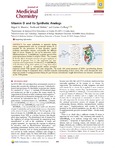Vitamin D and Its Synthetic Analogs

Use this link to cite
http://hdl.handle.net/2183/38901
Except where otherwise noted, this item's license is described as Creative Commons Attribution (CC-BY)License
Collections
- Investigación (FCIE) [1235]
Metadata
Show full item recordTitle
Vitamin D and Its Synthetic AnalogsDate
2019Citation
Maestro, M. A., Molnár, F., & Carlberg, C. (2019). Vitamin D and its synthetic analogs. Journal of Medicinal Chemistry, 62(15), 6854-6875. https://doi.org/10.1021/ACS.JMEDCHEM.9B00208
Abstract
[Abstract] For many individuals, in particular during winter, supplementation with the secosteroid vitamin D3 is essential for the prevention of bone disorders, muscle weakness, autoimmune diseases, and possibly also different types of cancer. Vitamin D3 acts via its metabolite 1α,25-dihydroxyvitamin D3 [1,25(OH)2D3] as potent agonist of the transcription factor vitamin D receptor (VDR). Thus, vitamin D directly affects chromatin structure and gene regulation at thousands of genomic loci, i.e., the epigenome and transcriptome of its target tissues. Modifications of 1,25(OH)2D3 at its side-chain, A-ring, triene system, or C-ring, alone and in combination, as well as nonsteroidal mimics provided numerous potent VDR agonists and some antagonists. The nearly 150 crystal structures of VDR’s ligand-binding domain with various vitamin D compounds allow a detailed molecular understanding of their action. This review discusses the most important vitamin D analogs presented during the past 10 years and molecular insight derived from new structural information on the VDR protein.
Keywords
Modification
Nutrition
Organic compounds
Peptides and proteins
Screening assays
Nutrition
Organic compounds
Peptides and proteins
Screening assays
Editor version
Rights
Creative Commons Attribution (CC-BY)License






